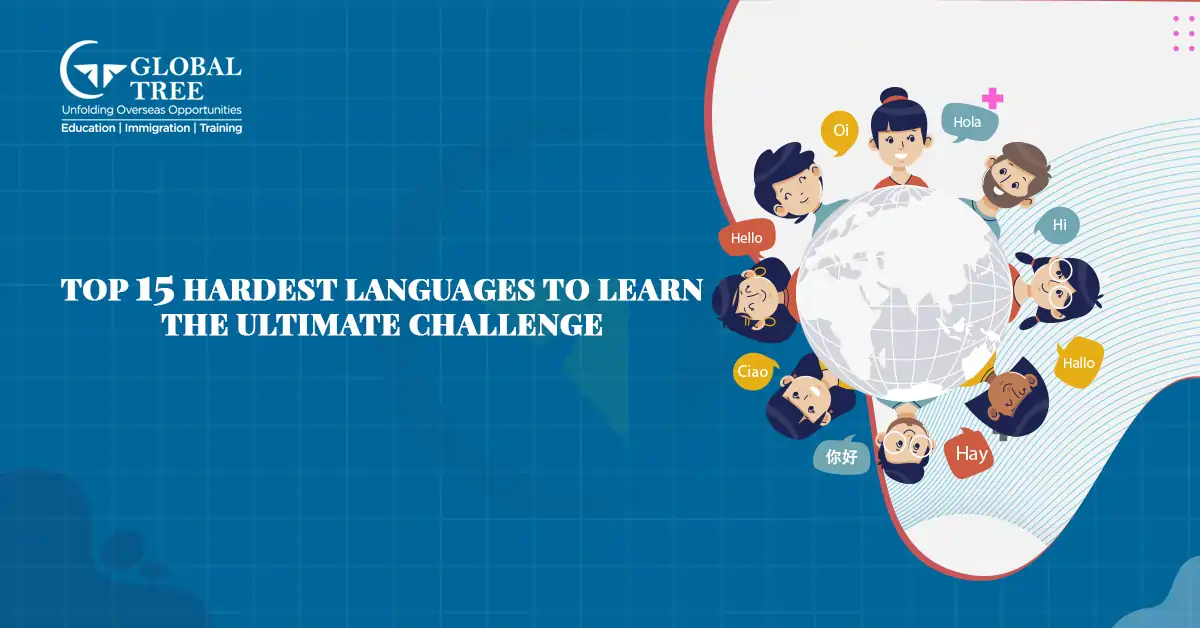10 Most Difficult Languages for Indians to Learn (2025 Rankings)

Introduction
Language is an important and beautiful part of human society and communication. Many of us find it easy to learn our first language, but learning a new one can be both difficult and satisfying. But some languages are known for being very hard and complicated. This blog will talk about the top 10 hardest languages to learn, including their scripts, whether they are recognized, and how many people speak them.
15. Mongolian
Script: Mongolian script (traditional) and Cyrillic script (in some regions)
Official Language of: Mongolia
Speaker Count: Approximately 6 million
● Mongolian has a unique style with vertical writing that makes it different from most other languages. It is spoken by about 6 million people
● The ancient writing system, Mongol Bichig, can be very hard to learn.
● There are a lot of different accents and rules for how vowels should sound together.
● Mongolian speech also varies a lot from one part of the country to another.
(Read More: 100 synonyms to strengthen your vocabulary)
14. Hebrew
Script: Hebrew script (Abjad)
Official Language of: Israel
Speaker Count: Approximately 9 million
● Hebrew is a Semitic language, and the Torah and other Jewish holy books are written in it.
● Modern Hebrew is easier to understand than ancient Hebrew, but it still has a difficult writing system and a complicated way of making words from roots.
● Heb. is written from left to right too.
13. Thai
Script: Thai script
Official Language of: Thailand
Speaker Count: Approximately 20 million
● That's right; Thai has five different tones that can change what words mean.
● Even though the writing is beautiful, it is hard to read because there are no breaks between the words.
● Thai has its own sentence patterns, particles, and grouping words. It is very hard for people to learn how to read and write Thai script.
12. Greek
Script: Greek alphabet
Official Language of: Greece, Cyprus
Speaker Count: Approximately 13 million
● Greek is both interesting and hard because it has a long past and has made important contributions to Western culture.
● There are a lot of different word cases and verb conjugations in it.
● The Greek alphabet came before the Latin alphabet, which is used in many Western languages. However, it can be hard for newbies to learn the characters and how they sound.
(Read More: Top 10 Affordable countries to study abroad)
11. Georgian
Script: Georgian script (Mkhedruli)
Official Language of: Georgia
Speaker Count: Approximately 4.7 million
● Georgian is a very old language that has its own font. There are many types of verbs, word cases, and verbal morphologies in this language.
● The letters in the Georgian script can make it hard for beginners to learn.
● Epic works like "The Knight in the Panther's Skin" are considered masterpieces of world literature and come from this language.
10. Polish
Script: Latin script
Official Language of: Poland
Speaker Count: Approximately 40 million
● Polish presents challenges with its intricate grammar, seven grammatical cases, and rich vocabulary.
● Like many other Slavic languages, Polish has a complicated system of word cases (seven in total) that show what a noun does in a sentence.
● Verbs change a lot depending on their tense, mood, and aspect, so conjugating them is very complicated.
● Because of its literary history and societal importance, the language is both appealing and difficult to learn.
[Read More: How to get Poland Work Visa for Indians?]
9. Navajo
Script: Latin script (with special characters)
Official Language of: Navajo Nation (USA)
Speaker Count: Approximately 169,000
● Navajo is a Native American language known for its complex verb morphology and unique sentence structure.
● Navajo is a Native American language that has a unique grammar based on verbs. Verbs have a lot of different forms and carry a lot of information.
● The language has a complicated system of classifiers that put words into groups based on their size, shape, and other traits.
● The Navajo language is in serious danger of dying out, but people are working to bring it back to life and protect its cultural importance.
(Read More: List of idioms to improve English proficiency)
8. Hungarian
Script: Latin script
Official Language of: Hungary
Speaker Count: Approximately 13 million
● Hungarian's agglutinative nature and numerous grammatical cases make it a tough language for non-native speakers.
● It is an agglutinative language, which means that words get more meaning by adding suffixes to them. This can make words long and hard to understand.
● Cases and name inflections are important parts of Hungarian grammar, but you can put words in pretty much any order you want.
● Even though Hungarian is written in a Latin-based script, some characters, like the double acute accent, may be new to students.
7. Icelandic
Script: Latin script
Official Language of: Iceland
Speaker Count: Approximately 330,000
● Icelandic is a challenging language due to its archaic vocabulary and grammar, which has changed little over the centuries.
● Icelandic is known for having a pure language, with words that haven't changed much over the years.
● The language still uses old-fashioned grammar rules, like four cases and a complicated system of declensions that show what a word does in a sentence.
● The fact that not many people speak Icelandic and that it is not spoken near other languages has helped keep its old-fashioned traits.
6. Finnish
Script: Latin script
Official Language of: Finland
Speaker Count: Approximately 5.5 million
● Finnish is known for its unique grammatical structure, including extensive case endings and vowel harmony.
● Finns are known for their 15 grammatical cases, which give words and pronouns differently
● Even though it's hard to learn, Finnish has a phonetic script that makes it easy to pronounce once you know the rules
(Read More: 15 tips to learn German quickly for a beginner)
5. Russian
Script: Cyrillic script
Official Language of: Russia, Belarus, Kazakhstan, Kyrgyzstan
Speaker Count: Over 258 million
● Russian's complex grammar, cases, and extensive vocabulary make it a formidable language to learn.
● Because Russian uses the Cyrillic script, people who want to learn the language need to get used to a new set of letters.
● It has a very complicated language with six grammatical cases that tell you what a noun does in a sentence and verb conjugations that depend on the tense and aspect of the verb.
● The language's large vocabulary and unusual phrases make it hard to learn.
4. Korean
Script: Hangul
Official Language of: North and South Korea
Speaker Count: Approximately 77 million
● Korean's script is relatively simple, but its grammar, honorifics, and honorific language levels pose significant challenges.
● Hangul is the Korean script. It is pretty simple and based on phonetics so that it is easy to learn. But learning the language is more than just learning the script.
● There are different levels of politeness, honorifics, and formal speech in Korean grammar, which makes encounters more difficult.
● In Korean, pronunciation and phrasing are very important because even small changes can cause confusion.
3. Japanese
Script: A combination of three scripts - Kanji, Hiragana, and Katakana
Official Language of: Japan
Speaker Count: Approximately 127 million
● Learning Japanese involves mastering thousands of Kanji characters and adapting to its unique sentence structure and politeness levels.
● The writing system in Japanese is very difficult because it uses three different types of characters: Kanji, which are ideograms taken from Chinese, Hiragana, which is a syllabary, and Katakana, which is used for foreign loanwords.
● There are different levels of politeness and honorifics in the language that you need to learn in order to talk to people in different social situations.
● Japanese sentences are built with a subject, an object, and a verb (SOV), which is different from English and many other languages.
(Read More: Homophones vs Homonyms vs Homograms: Know the differences)
2. Arabic
Script: Arabic script (Abjad)
Official Language of: 26 countries in the Arab League
Speaker Count: Over 300 million
(Read More: Study Linguistics course abroad)
● Arabic has a very complicated script that is written from right to left. It also has a lot of different accents that can be very different from one place to another.
● The script for Arabic, a Semitic language, goes from right to left. The Arabic writing system, called Abjad, is cursive and can be hard for newbies to figure out.
● There are many types of Arabic, and the words and sounds used in different areas are very different. This is the official writing form of Arabic used all over the Arab world.
1. Mandarin Chinese
Script: Chinese characters (Hanzi)
Official Language of: China, Taiwan, Singapore
Speaker Count: Over 1 billion
● Mandarin Chinese tops our list as one of the most challenging languages to learn. Its tonal nature, complex writing system, and vast vocabulary make it a formidable linguistic feat.
● Mandarin Chinese is the most spoken language in the world, mostly because so many people live in China. As a logographic writing system, Hanzi is used for it. This means that each character stands for a word or an important part of a word.
● The language has four main tones and a middle tone, which makes it hard for people who don't speak it as their first language. A change in tone can make a word mean something completely different.
● It's not enough to just learn how to say words in Mandarin; you also need to know how to write the characters and how to put them together.
Conclusion
If you want to learn one of these languages, you should know that it's not for the weak of heart. Each has its own set of problems, such as learning complicated scripts and language or figuring out how to deal with cultural differences. However, the benefits are huge. Learning a hard language broadens your views, helps you understand other cultures, and changes the way you see the world.
So, whether you choose to learn the complicated tones of Mandarin Chinese or the tricky grammar of Hungarian, remember that learning a language is a good thing to do.
FAQs:
1. Should you try to learn a hard language?
A: Of course! Sometimes it's very beneficial to learn a difficult language. As a result, it lets in new societies, ideas, and chances. It also makes you smarter and better at handling problems.
2. Which hard language is the most useful to learn?
A: Whether or not learning a hard language is useful depends on your goals. Languages like Mandarin Chinese, Arabic, and Spanish are widely spoken and can help you get ahead in your work. But the choice you make should be in line with your goals and hobbies.
3. How long does it take to learn a language that is hard to understand?
A: How long it takes to become fluent in a difficult language depends on many things, such as your mother language, how you learn, and how often you study. Most of the time, steady work over a number of years is needed to become proficient.
4. What are some good ways to learn languages that are hard to learn?
A: Immersion, consistent practice, using language learning apps and tools, looking for people to talk to, and setting realistic goals are all good ways to learn a language. It's important to adapt your technique to the challenges of the language.
5. Are there quick ways to learn languages that are hard to understand?
A: There aren't any real quick fixes, but there are some things that can help you learn faster. Some of these are practicing regularly, focusing on high-frequency words, and using mnemonics to remember difficult language rules and words.









